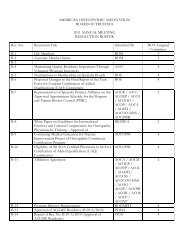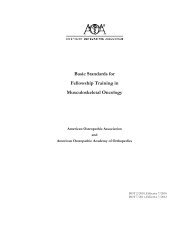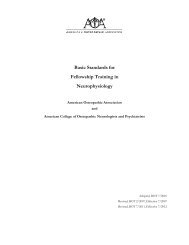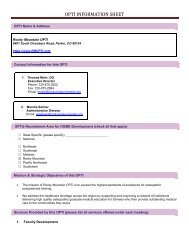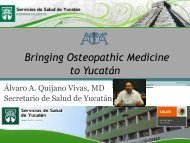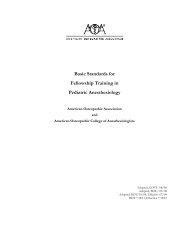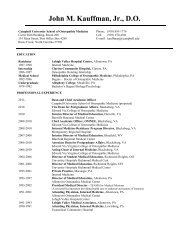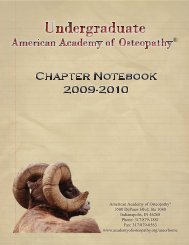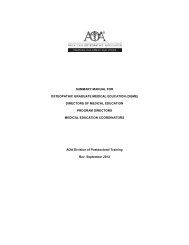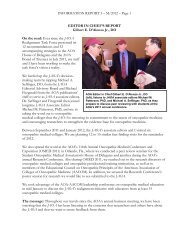Dialogue and Diagnosis - American Osteopathic Association
Dialogue and Diagnosis - American Osteopathic Association
Dialogue and Diagnosis - American Osteopathic Association
You also want an ePaper? Increase the reach of your titles
YUMPU automatically turns print PDFs into web optimized ePapers that Google loves.
the fact that he was obviously upset<br />
at the time it was measured. His<br />
HbA 1c level was 9.1%. As his phenotype<br />
was not typical for T2DM, <strong>and</strong><br />
his treatment had little durability<br />
despite his significant lifestyle efforts<br />
the consideration for atypical types<br />
of diabetes was entertained. These<br />
patients may be the “thin diabetics”<br />
<strong>and</strong> often have family history of<br />
other autoimmune diseases. Nearly<br />
10% of adults (>35 y/o) who think<br />
they have T2DM actually have a<br />
slowly progressive form of T1DM.<br />
Autoimmune antibodies (GAD65)<br />
were ordered as was the test for<br />
endogenous glucose production<br />
(c-peptide in conjunction with serum<br />
glucose). Alternatively, people from<br />
ethnic minorities, especially men of<br />
African descent can have a form of<br />
T2DM that is prone to go to diabetic<br />
ketoacidosis. This has been termed<br />
ketosis prone T2DM or “Flatbush diabetes”—named<br />
after a street in the<br />
Bronx in which this pattern was first<br />
described.<br />
Islet-cell cytoplasm autoantibodies<br />
<strong>and</strong> glutamic acid decarboxylase<br />
autoantibodies (GADAs) can occur in<br />
patients with apparently typical<br />
T2DM. Data from the United<br />
Kingdom Prospective Diabetes Study<br />
25, or UKPDS 25 12 showed that<br />
among patients older than 45 years,<br />
the presence of GADAs was highly<br />
predictive of the likelihood of insulin<br />
requirements. In the ADOPT trial,<br />
10% of the T2DM study population<br />
had GAD antibodies. 13<br />
The (GAD65) antibody was negative<br />
<strong>and</strong> his c-peptide was normal<br />
despite mild hyperglycemia (FSG<br />
140 mg/dl).<br />
Sam’s physician explained that in<br />
light of his significant hyperglycemia<br />
<strong>and</strong> the fact he has contributed so<br />
significantly to his control that<br />
insulin would be the safest <strong>and</strong> most<br />
effective therapy. The physician also<br />
explained that insulin has been a<br />
“tried <strong>and</strong> true” life-saving therapy<br />
for almost a century. Also as a<br />
hormone replacement it may have<br />
less side effects <strong>and</strong> drug interactions<br />
than most oral medications.<br />
As a side note, if Sam were not<br />
slim <strong>and</strong> if he had a preponderance<br />
of postpr<strong>and</strong>ial hyperglycemia<br />
without an elevated fasting blood<br />
glucose level, then the short-acting<br />
glucagon-like peptide-1 (GLP-1)<br />
receptor agonist exenatide would be a<br />
treatment option. Because the longeracting<br />
GLP-1 receptor agonists lower<br />
both fasting <strong>and</strong> postpr<strong>and</strong>ial blood<br />
glucose levels, they would also be<br />
options in this type of case, especially<br />
if weight loss is a consideration.<br />
However, because Sam was relatively<br />
slim with high FPG <strong>and</strong> HbA 1c levels,<br />
insulin was his best option for therapeutic<br />
addition.<br />
Sam was instructed regarding how<br />
to use an insulin pen, including the<br />
appropriate injection sites (ie,<br />
abdomen, outer arms, <strong>and</strong> thighs).<br />
See Figure 1. Upon placing the needle<br />
on the pen, he was shown how to do<br />
a 2-unit “air-shot” (ie, dialing up the<br />
pen to 2 units <strong>and</strong> ejecting a drop of<br />
insulin into the air to ensure that the<br />
injection would deliver the correct<br />
Figure 1. Site selection<br />
for insulin injection.<br />
The most common injection site is<br />
the abdomen or stomach. Other sites<br />
that can be used include the back of<br />
the upper arms, the upper buttocks<br />
or hips, <strong>and</strong> the outer side of the<br />
thighs. These sites are recommended<br />
because they have a layer of fat just<br />
below the skin to absorb the insulin<br />
but not many nerves, which means<br />
that injection at the site will be more<br />
comfortable to the patient than<br />
injection in other parts of the body.<br />
Injection at these sites also make it<br />
easier for the patient to inject into the<br />
subcutaneous tissue.<br />
amount of insulin with no air<br />
bubbles). When administering the<br />
injection, he was advised to count to<br />
6 to ensure that the full dose of<br />
insulin was delivered prior to<br />
withdrawing the needle from the<br />
injection site. The needle for the pen<br />
was short <strong>and</strong> 32 gauge. Sam was<br />
amazed how small <strong>and</strong> thin the<br />
needles were <strong>and</strong> was pleasantly surprised<br />
that he did not feel pain with<br />
the injection. Part of the education<br />
provided to Sam was to stress that the<br />
needle should be changed with each<br />
injection.<br />
Sam began injecting 10 units of a<br />
basal insulin analog every night at<br />
bedtime. The PREDICTIVE 303 algorithm<br />
was given to Sam to enable<br />
him to self-titrate his insulin<br />
(Table 1). 14 He had always checked<br />
his fasting blood glucose levels daily<br />
<strong>and</strong> was amenable to being even<br />
more involved with his therapy, with<br />
the assurance that he would receive<br />
guidance from his physician.<br />
Increased self-monitoring of blood<br />
glucose levels gave him further feedback<br />
<strong>and</strong> a sense of empowerment.<br />
His fasting blood sugar (FBS) goal was<br />
between 80 <strong>and</strong> 130 mg/dL, which<br />
was individualized to his situation<br />
<strong>and</strong> which is a bit more lenient than<br />
<strong>Dialogue</strong> <strong>and</strong> <strong>Diagnosis</strong> // September 2012<br />
3



